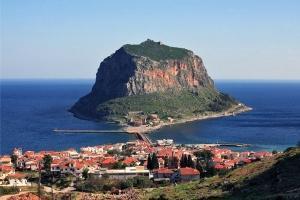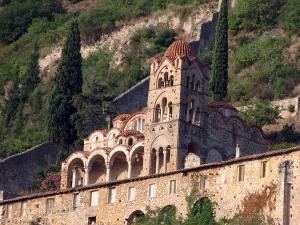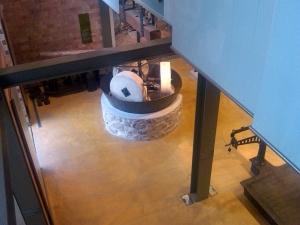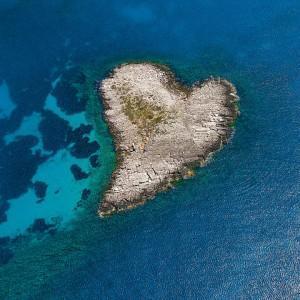Lakonia (Laconia): Myth, History and Reality
Once upon a time, at very old times, King Tyndareos lived in Sparta with his beautiful wife, Leda. Leda would regularly go to the banks of the Evrotas River and wash her hair in its waters, among reeds and laurels. That’s where Zeus saw her, fell in love and desired his union with her. He transformed himself into a swan in order to approach her and ultimately possess her.
Leda started playing with him at the river’s sparkling waters. Suddenly, an eagle rushed to tear the swan to pieces. It was god Hermes, in disguise, following Zeus’ orders. Leda opened her arms to protect the swan and Zeus had the chance to sexually unite with her. From this union, Leda gave birth to an egg. It was Helen of Sparta who came out of this egg, whom fate had destined to become the most beautiful woman, Helen of Troy. The story that follows is real and has nothing to do with the things you already know, but it will be a wonderful journey through space and time.
 |
| The Rock of Monemvasia |
If the three most important elements for humans are Power, Wisdom and Beauty, with Love and Eros as intrinsic parts of Beauty, then these qualities have defined the fate of Helen's, the fate of Hellenism, and they still define everybody's life today. The beautiful things, the most beloved, are within ourselves. As it happens in Nature, beauties are hidden and one must constantly be in the process of discovering them. Thankfully, Nature hides and protects them all.
Where did Helen actually spend her childhood and teenage years? The surroundings of the palace were dominated by the revered Mt. Taygetos, the male mountain. This mountain, with its vast heart of stone, conceals its beauty, and its morale is autonomous. In the very same words one could describe Greece. This is a mountain unlike any other on the earth. Mt. Taygetos is a castle, rising above and beyond any faint-heartedness. Its vision is the biggest musical revelation of the Greek landscape which hits you hard and nails you down, as a strike of genius. The soul of ancient Sparta is chained to the mountain’s sides like Prometheus. This soul is the triumph of thought and reason, a triumph of freedom and duty.
Helen of Troy was lucky to have grown and flourished in a place where the most glorious page for women was written during the Archaic Era, with the legislation of Lycurgus. His rule was Harmony through Absolute Virtue and Happiness. Women in Sparta, under Lycurgus’ Laws, had the right to inherit and to bequeathe, so they were the virtual owners of the family holdings, therefore, the chief members of the families. In order to understand how advanced the society was, we must keep in mind that women in Sparta spent most of their time outdoors at the gymnasiums and at the open-air celebrations such as the “Gymnopaediae”(=“Naked Children”) events where the youth of Sparta danced, sang and competed against one another while naked. Sparta, through Lycurgus’ educational system, became the most liberated State. Plutarch writes: “A Laconian would allow his wife to reproduce with another man while she’d still live with him at his house and their marriage keep its original meaning.” It was as if a sower “was planting in a fertile land.” Herodotus tells us that “the institution of monogamy" was so loose and the looseness of morals was such that adultery, divorce and prostitution were rare occurrences.”
There are many theories as to whether Lycurgus was a god, a philosopher or a legislator, as there is no evidence, apart from writings by his enemies, the Athenians. Lycurgus is mentioned as a solar god fighting against the dark powers and deities of Hades. It is said that his Laws were dictated by Apollo himself. “Lycurgus" means “he whose acts are luminous”, deriving from the Greek roots “lyc” [light] (whence the Latin lux) and “ergon” [work]. The views of the Spartan society were and are more progressive and dynamically expressed in modern philosophy and art. When a man and a society have power, wisdom and beauty, and utilize them for their well-being and to live in harmony, they do not need enactments in order to find truth and the ideal they live with to enjoy these qualities.
Helen of Sparta grew amidst all kinds of fragrances, both natural and man-made. Hand-kneaded bread, basic to the diet of ancient Spartans, was one of them. Made with fresh ingredients and yeast, which releases the aroma of grains and smells delightful. Today, when the world uses chemicals and preservatives and all pure smells and tastes have been set aside, here in Sparta one can still find, following his or her sense of smell, this specific kind of bread at a local bakery.
If while walking through the streets of Sparta you suddenly hear children's voices, you may be very near the Art Gallery. Lycurgus would be happy to know that most institutes and organizations in Sparta are, still today, managed by women. Most artifacts in antiquity had a role to play, either in education or at rituals, and when you discover that modern education goes through this stage and museums become schools, you realize that Sparta is, once again, a pioneer. You can enjoy visiting the central library of Sparta, with more than 70,000 volumes and being one of the largest in Greece. It has a children's and an adult's section, one with modern audiovisual means, computers, CD, CD-Rom, DVD, an information center with Laconian press and magazines and books by all Laconian authors. An important section houses the archive of the prominent Laconian poet Nikiforos Vrettakos.
Going round in museums and admiring sculptures of wild boar and then meeting pigs at large in village streets, you could wonder which is more important: Life or Art? Life or its enactment? Anyway, there’s no dish in the world like roast piglet. It has always been a traditional dish of Lakonia. It can be eaten as a sausage or salted. The sausage contains salt, pepper, savory, orange. The salted one is covered with thick salt and stays like this for five days in order to absorb it. It then is smoked with sage (Artemisia tridentata), cypress and thyme for another two days, until it is dry and has taken in all necessary aromas. It is then boiled with wine, olive oil, cumin, spices, cinnamon sticks and orange peels. Once it’s cool, it is put in a jar with oil, where it can be preserved for a year. This was also basic in Helen's and all Lacedaemonians’ diet, when one only piece could keep them fit for a whole day. The question, though, remains: Art or Life? The answer is common in the Laconian society: The Art of Living!
 |
| Perivleptos Church, Mystras |
From Menelaϊon, where Helen of Troy lived when it was a rich palace, while now it’s just in ruins, every morning she would look at the Mystras hills through her window. She'd leave and go for walks through the old trails, which have now been rebuilt, and she would walk as long as the Mystras hills, a reviving walk even today. On these hills today are the ruins of medieval Mystras. Many such cities are in ruins but none has the poetic atmosphere of Mystras, because Mystras died suddenly, at the “peak of its life and power," same as Pompeii did, to which it has many resemblances. It has the mysterious atmosphere of a theater just after the end of the performance. One feels that, at any time, he may witness a slow silent procession of people belonging to History and Dreams… The Frank Ruler, William Villehardouin, who founded the castle in 1249, the last Byzantine Emperor Konstantine Palaeologos, Franks, Venetians, Turks, Byzantines, Greeks, monks, the high society, painters, hagiographers… The philosopher could interact with the artist, and Plato engaged in discussion with Plethonas Gemistos. In some of the church frescoes are depicted the last soldiers of Palaeologos, swept by the winds on the rocks, wasted away, their eyes bruised and illuminating from the heat, sleeplessness and dismay. Their hands and legs are bony, their bodies slim like ghosts, warriors of a kingdom beyond this world. Like their master, Constantine, they know their unfortunate fate. But they also know that what they will do in their last moments, the very way they die, is beyond their choice, because it will serve as a lighthouse to the whole of Hellenism in the many centuries to follow, proud defenders of a civilization which has dazzled humanity.
|

|
|
Pantanassa Church, Mystras
|
If one is sharing the basics of modern Greek civilization, he or she could look at Mystras with the eyes of Greek authors and poets. Everyone will tell you stories: Kazantzakis, Papadiamandis, Kontoglou, Tsarouchis, Mirivilis, Ouranis, Yiannis Ritsos, Sikelianos and so many others. One day, Kazantzakis, as he was walking through the ruins, heard a divine music, as the wind sighed along with him and, suddenly, the entire space was filled with ghosts: the knights who arrived to Peloponnese to conquer it. They married Greek women, and they forgot their homeland. The conquerors have been conquered by the dark complexioned, black haired and large-eyed Greek women. When I was working at Mystras, he narrates, I would sometimes stay on my own at Perivleptos Church. Over the evening, the church was dark and frightening. I could hear footsteps on the scaffoldings. “it must be a ghost walking” I thought, and I turned my head to where they had drawn the soldiers and the warriors. They were standing in rows, just a bit higher than ground level, most of them with their eyes chiseled out, injured at the chest, many of them torn by sword cuts. Many faces only had one eye, but that one drawn eye could see better and farther than ten living ones. Good Lord! I had spent years in that church and I still shivered with all these, a chill piercing all of me. Those grass walls were alive, hearts beating, nerves stretched, swords, arrows, shields landing on those bodies… “And an earthquake happened, and the bones moved at both sides towards a harmonious resolution.” Mystras is beyond time and life, it belongs to eternity, it is both Frankish and Byzantine, Turkish, Peloponnesian and Greek. Mystras is universal. Mystras is the cultural center of Europe. That’s what Goethe sensed when he made Helen of Troy meet Faust on Mystras’ vast palace terraces.
 |
| Olive Oil Museum, Sparta |
And this is where Poetry begins. The most beautiful sculptures in the world are those perennial olive tree trunks. The museum of Olives and Greek olive oil at Sparta is one of the most important museums in Europe. Laconian olives, and the oil derived from them, is the driving force of both ancient and modern Greek bodies. The gift from Goddess Athena, equally important to the fire donated by Prometheus. The olive tree is a blessed, undefeatable, immortal tree whose leaves are of the same color as the Goddess’ eyes. Sea-green is a glittering, dazzling color with shades of green and blue and of silver-white and gray. It’s like the color of the sea when the sun mirrors itself on it, of the full moon and the stars’ dawn, of women’s bright eyes when they are in love. Olive oil is the most important part of our diet and it guards us against disease. The stories of 90 year old people from Mani are all too frequent: every day, throughout their lives, since their childhood, at 10 every morning, when mothers and, later, wives, took the hand-kneaded bread off the oven, they would eat one slice drenched in olive oil. Every day, in all these years, they would never get ill nor would they take any drugs. And the local humor is endless, repeating the same old proverb told by Greek women again and again: “Eat oil and come in the evening” (‘oil’ and ‘evening’ rhyming in Greek!).
 |
|
The Loving Heart of the Aegean Sea
|
|
|



